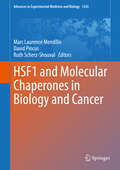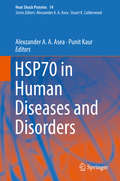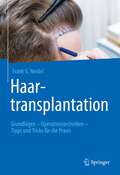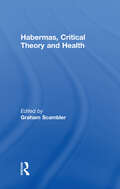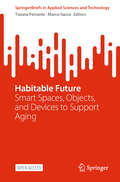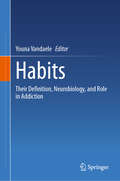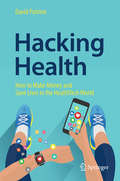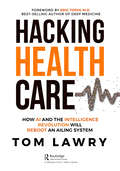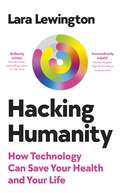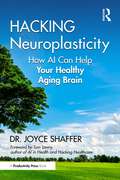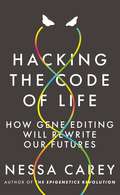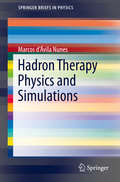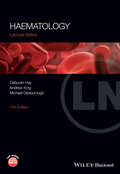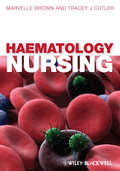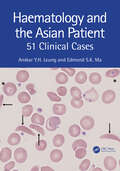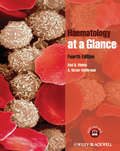- Table View
- List View
HSF1 and Molecular Chaperones in Biology and Cancer (Advances in Experimental Medicine and Biology #1243)
by David Pincus Marc Laurence Mendillo Ruth Scherz-ShouvalProtein homeostasis, or “Proteostasis”, lies at the heart of human health and disease. From the folding of single polypeptide chains into functional proteins, to the regulation of intracellular signaling pathways, to the secreted signals that coordinate cells in tissues and throughout the body, the proteostasis network operates to support cell health and physiological fitness. However, cancer cells also hijack the proteostasis network and many of these same processes to sustain the growth and spread of tumors. The chapters in this book are written by world experts in the many facets of the proteostasis network. They describe cutting-edge insights into the structure and function of the major chaperone and degradation systems in healthy cells and how these systems are co-opted in cancer cells and the cells of the tumor microenvironment. The chapters also cover therapeutic interventions such as the FDA-approved proteasome inhibitors Velcade and Krypolis as well as other therapies currently under clinical investigation to disarm the ability of the proteostasis network to support malignancy. This compendium is the first of its kind and aims to serve as a reference manual for active investigators and a primer for newcomers to the field. This book is dedicated to the memory of Susan Lindquist, a pioneer of the proteostasis field and a champion of the power of basic scientific inquiry to unlock the mechanisms of human disease.
HSP70 in Human Diseases and Disorders (Heat Shock Proteins #14)
by Alexzander A. Asea Punit KaurThe book HSP70 in Human Diseases and Disorders provides the most comprehensive review on contemporary knowledge on the role of HSP70 family - one of the most studied HSP - in human diseases and disorders. Using an integrative approach to expand our current understanding of HSP70 functions, the contributors provide a synopsis of novel mechanisms by which HSP70 is involved in the regulation of human diseases and disorders. Key basic and clinical research laboratories from major universities and academic medical hospitals around the world contribute chapters that review present research activity and importantly project the field into the future. The book is a must read for medical students and residents, clinical and basic science researchers, postdoctoral fellows and graduate students in the fields of Medicine, Physiology, Clinical Trials, Biotechnology, Molecular Medicine and Pathology.
Haarerkrankungen in der dermatologischen Praxis
by Wolfgang RaabVerlust der Haare, übermäßiges Haarwachstum und Veränderungen der Haare sind nicht nur ein ästhetisches Problem. Sie können auch Hinweise auf unterschiedlichste Erkrankungen geben. Praxisnah werden in dem Band die Entstehung, Diagnose und Therapie des Haarausfalls bei Männern, Frauen und Kindern, von Hypertrichosen und weiteren Erkrankungen wie z. B. Kopfschuppen erläutert. Die richtige Diagnose kann dazu beitragen, Mangelerkrankungen, hormonale Dysregulationen, Stoffwechselstörungen oder sogar die Entwicklung von Tumoren bei Patienten aufzudecken.
Haartransplantation: Grundlagen – Operationstechniken – Tipps und Tricks für die Praxis
by Frank G. NeidelDieses Buch beschreibt alle aktuellen Techniken der Haartransplantation.Der Autor gibt zahlreichen Tipps und Tricks für den Praxisalltag.
Habermas, Critical Theory and Health
by Graham ScamblerThe contribution of the German sociologist and philosopher Jurgen Habermas has proved seminal for attempts to understand the nature of social change in the context of global capitalism. This book provides an accessible introduction to his work and shows how his theories can be fruitfully applied to a wide range of topics in the sociology of health and illness including: * lay health knowledge * doctor-patient interaction* health care decision-making * health inequalities * new social movements in health * health care rationing * the Foucault perspective. Habermas, Critical Theory and Health will open up both new issues and new lines of empirical enquiry which will be of special interest to teachers and students of social theory and the sociology of health and illness and offers healthcare professionals new perspectives on their practice.
Habitable Future: Smart Spaces, Objects, and Devices to Support Aging (SpringerBriefs in Applied Sciences and Technology)
by Marco Sacco Tiziana FerranteThis open-access book presents a multidisciplinary approach to the design of living spaces from an age-friendly perspective, in line with the Ambient Assisted Living (AAL) paradigm, which promotes the integration of assistive devices and technologies to create safe, comfortable environments that meet the needs of older adults and their caregivers. It outlines new operational strategies, incorporating an analysis of technological development trends focused on the well-being and health of older adults, identifying their needs and expectations through participatory processes, and establishing design requirements to foster the acceptance of interfaces and emerging devices. In light of the exponential increase in smart applications within living environments, the book emphasizes the necessity to introduce cutting-edge solutions for data transmission and processing, as well as the development of semantically driven tools to support designers in selecting and integrating assistive technologies through virtual environment simulations. The book also illustrates the methodological processes adopted in defining guidelines for the design of spaces dedicated to older adults, with attention to architectural and functional aspects in various domains: perceptual and sensory factors for the design of waiting areas in Community Houses, technological and environmental requirements for the integration of devices in home adaptation projects for Home Care and locational and typological criteria for the development of new Social Day Care Centers. These contributions are based on the experiences shared during the conference organized by the WP1 "Human-Centred Design and Evaluation, Certifications, Sustainability within the Built Environment" of Spoke9, within the framework of the Age-It/NRRP program.
Habits: Their Definition, Neurobiology, and Role in Addiction
by Youna VandaeleThis book explores the multiple facets of habit from diverse and complementary theoretical frameworks. It provides a complete overview of the cognitive, computational, and neural processes underlying the formation of distinct forms of habit. The objective of the book is to cover (1) the multiple definitions of the habit construct and the relation between different habit-related concepts, (2) the underlying brain circuits of habits, and (3) the possible involvement of habits in psychiatric disorders such as alcohol and substance use disorder. This book will be of interest to all researchers in behavioral and computational neuroscience, psychology, and psychiatry who are interested in associative learning and decision making, under normal and pathological conditions.
Habitualisierung im ärztlichen Feld: Die fachärztliche Weiterbildung in Struktur und kultureller Praxis am Beispiel der Chirurgie
by Sarah PredigerDie fachärztliche Weiterbildung ist ein wesentlicher Teil des beruflichen Sozialisierungsprozesses der Ärztinnen und Ärzte. Dieser kann auch als Habitualisierungsprozess untersucht werden, da hier – neben dem Medizinstudium – die wichtigen ärztlichen Dispositionen erlernt und in den eigenen Habitus übernommen werden. Am Beispiel der chirurgisch-fachärztlichen Weiterbildung wird in diesem Buch analysiert, welche formale Weiterbildungsstrukturierung laut Weiterbildungsordnung seitens der ärztlichen Selbstverwaltung festgelegt wurde, wie sich diese über die Jahre entwickelte und welche Weiterbildungspraktiken sich in den Kliniken zeigen. Letzteres bildet das Herzstück der Arbeit. Anhand qualitativer Interviews mit Ärztinnen und Ärzten wird eine Feldanalyse nach Pierre Bourdieu durchgeführt und dabei ein ausführlicher Blick auf die kulturellen Gegebenheiten geworfen, in denen die ‚geplante‘ Struktur auf die Realität der Klinik trifft. Dieser spannende Einblick in die ärztliche Welt ermöglicht den Leserinnen und Lesern aus dem sozialwissenschaftlichen Bereich die Feldstrukturen und -regeln besser zu verstehen. Leserinnen und Lesern aus dem ärztlichen Bereich wird ein Gefühl des Wiedererkennens ihrer ärztlichen Realität ermöglicht, wobei Reflexionsprozesse angestoßen werden können. Beides kann dazu beitragen, die Zusammenhänge besser zu verstehen und so Veränderungsprozesse zur Optimierung der fachärztlichen Weiterbildung realitätsnäher zu diskutieren und gemeinsam anzustoßen.
Hacker And Moore's Essentials Of Obstetrics And Gynecology
by Neville F. Hacker Joseph C. Gambone Calvin J. HobelHacker & Moore's Essentials of Obstetrics and Gynecology, by Drs. Neville F. Hacker, Joseph C. Gambone, and Calvin J. Hobel, is the #1 choice of ob/gyn residents and medical students because of its concise focus, comprehensive coverage, and easy-to-use format. This new edition features updated clinical cases and assessments, new Clinical Key boxes, and thoroughly revised text and images that reflect today’s best knowledge on the evaluation, diagnosis, and management of a wide range of ob/gyn disorders.
Hacking Health: How to Make Money and Save Lives in the HealthTech World
by David PutrinoThis book is a must-read guide for those entering the world of HealthTech startups. Author David Putrino, a veteran in the world of HealthTech and Telemedicine, details the roles, necessity, and values of key members of a typical HealthTech team, and helps readers understand the motivations and core priorities of all people involved. In ventures that typically depend upon effective communication between members from business, science, regulatory, and academic backgrounds, this book helps develop the core competencies that team members need to work harmoniously. Four detailed case studies are shared that exemplify the spectrum of HealthTech possibilities, including large corporations, tiny startups, elite athletes, and social good enterprises. Each case study shows how the success or failure of a project can hinge upon strong team dynamics, a deep understanding of the target population's needs and a strong awareness of each team member’s long-term goals. This book is essential reading for entrepreneurs, scientists, clinicians, marketing and sales professionals, and all those looking to create new and previously unimagined possibilities for improving the lives of people everywhere.
Hacking Healthcare: How AI and the Intelligence Revolution Will Reboot an Ailing System
by Tom LawryIn this original work, Tom Lawry takes readers on a journey of understanding what we learned from fighting a global pandemic and how to apply these learnings to solve healthcare's other big challenges. This book is about empowering clinicians and consumers alike to take control of what is important to them by harnessing the power of AI and the Intelligent Health Revolution to create a sustainable system that focuses on keeping all citizens healthy while caring for them when they are not.
Hacking Humanity: How technology can save your health and your life
by Lara LewingtonAS SEEN ON 'SUNDAY BRUNCH' AND 'THIS MORNING''Absolutely brilliant' JEREMY VINE'No-one explains cutting edge technology more clearly than Lara' LORRAINE KELLY'Brilliantly written ... separates the nonsense from the evidence' RUSSELL FOSTER, bestselling author of Life Time'Extraordinarily helpful' DAMIAN HUGHES, bestselling author and host of High PerformanceDISCOVER HOW NEW TECHNOLOGY CAN MAKE YOU HEALTHIER FOR LONGERIn Hacking Humanity, technology journalist Lara Lewington takes us to the cutting edge of scientific research to demystify how new innovations are transforming our healthcare for the better. Drawing us into the science behind the world’s healthiest people, from the Blue Zones to Silicon Valley, while experimenting with the new technology already available, she examines the real challenges ahead and how we can overcome them.This holds the power to significantly increase the amount of time we spend living in good health – and may boost our lifespans in the process too.Discover how you can harness the power of data to start improving and protecting your future health right now, and learn how the world’s leading experts are developing technologies that will help us all enjoy more of our lives in the years to come.
Hacking Neuroplasticity: How AI Can Help Your Healthy Aging Brain
by Joyce ShafferNeuroplasticity is the ability of neural networks in the brain to change through growth and reorganization. It is when the brain is rewired to function in some way that differs from how it previously functioned.How does aging affect neuroplasticity? As we grow older, plasticity decreases to stabilize what we have already learned. What influence does the aging process have on memory? Forgetfulness can be a normal part of aging. As people get older, changes occur in all parts of the body, including the brain. As a result, some people may notice that it takes longer to learn new things, they don't remember information as well as they did, or they lose things like their glasses. This book on evolving neuroscience is unique in its lifespan focus on driving neuroplasticity in a positive direction to influence the Flynn effect of increasing human intelligence as the preferred way to prevent, delay onset, and/or reverse dementia. It considers potential impact from the first moments of life through end of life. It includes intergenerational activities. Its inclusion of centenarians and supercentenarians provides examples of “Super Agers” who have maintained and/or increased neurocognitive capacity, often with a health span that approximated their vigorous longevity. It discusses the use of the Artificial Intelligence (AI) revolution to refine, personalize, and broaden our global reach to enhance the Flynn effect as the preferred effort to improve global statistics on neurocognitive functioning at any age. Driving neuroplasticity in a positive direction at all ages is urgent.With this book’s focus on evidence-based interventions at any age which can have physical, emotional, neurobiological, neurochemical, immunological, and social health benefits, it is a unique overview and application of evolving neuroscience to address the UN/WHO Decade of Action for Healthy Ageing for All.
Hacking The Code Of Life: How Gene Editing Will Rewrite Our Futures (Hot Science)
by Nessa CareyIn 2018 the world woke up to gene editing with a storm of controversy over twin girls born in China with genetic changes deliberately introduced by scientists - changes they will pass on to their own offspring. <p><p> Genetic modification (GM) has been with us for 45 years now, but the new system known as CRISPR or gene editing can manipulate the genes of almost any organism with a degree of precision, ease and speed that we could only dream of ten years ago. <p> But is it ethical to change the genetic material of organisms in a way that might be passed on to future generations? If a person is suffering from a lethal genetic disease, is it unethical to deny them this option? Who controls the application of this technology, when it makes 'biohacking' - perhaps of one's own genome - a real possibility? <p> Nessa Carey's book is a thrilling and timely snapshot of a cutting-edge technology that will radically alter our futures and the way we prevent disease.
Hadron Therapy Physics and Simulations
by Marcos D'Ávila NunesThis brief provides an in-depth overview of the physics of hadron therapy, ranging from the history to the latest contributions to the subject. It covers the mechanisms of protons and carbon ions at the molecular level (DNA breaks and proteins 53BP1 and RPA), the physics and mathematics of accelerators (Cyclotron and Synchrotron), microdosimetry measurements (with new results so far achieved), and Monte Carlo simulations in hadron therapy using FLUKA (CERN) and MCHIT (FIAS) software. The text also includes information about proton therapy centers and carbon ion centers (PTCOG), as well as a comparison and discussion of both techniques in treatment planning and radiation monitoring. This brief is suitable for newcomers to medical physics as well as seasoned specialists in radiation oncology.
Haematology (Lecture Notes)
by Andrew King Deborah Hay Michael DesboroughThe definitive overview of haematology and its recent developments Haematology has advanced considerably in recent decades. As new developments emerge, there is a continuous need for an accessible and up-to-date survey for medical students, discussing the major haematological disorders, their clinical presentations, their treatments, and more. Written by specialists with an interest in medical education, Lecture Notes: Haematology is a succinct, highly illustrated student guide to the essentials of this important field. It integrates the physiological, pathological, and clinical dimensions of haematology in a single comprehensive guide, and provides medical students and early-career clinicians with the core knowledge required to succeed in the subject. The 11th edition of this guide includes updated sections and expanded chapters detailing the newest advances in the field. In this 11th edition of Lecture Notes: Haematology, readers will also find: Discussion of both pathogenesis and management of all major haematological disorders Online clinical cases with >150 multiple choice questions to allow you to test and apply your knowledgeLecture Notes: Haematology, 11th edition is a valuable resource for medical students and junior doctors looking to increase their expertise in this medical specialty.
Haematology Nursing
by Marvelle BrownHaematology Nursing is a comprehensive handbook, with a nursing focus, on the care and management of patients with haematological disorders. Divided into four sections, the first provides an introduction to haematology, looking at haemopoiesis, immunology and genetics. Section Two covers non-malignant haematology, including anaemia, haemoglobinopathies and haemochromatosis. Section Three explores the pathophysiology, care and management of myeloproliferative and lymphoproliferative disorders, including leukaemia, myeloma, and lymphoma. The final section provides information on various nursing care interventions, including blood transfusion, venous access devices, and palliative care. Aimed principally at nurses working in a variety of settings including haematology/oncology wards, medical/haematology wards, specialist bone marrow transplant centres, and community settings, Haematology Nursing is an essential and much-needed reference guide.
Haematology and the Asian Patient: 51 Clinical Cases
by Anskar Y.H. Leung Edmond S MaHaematology encompasses a broad range of topics ranging from common and relatively benign conditions such as iron deficiency anaemia, hereditary diseases such as thalassaemia, to haematological malignancies that are often life-threatening. Burgeoning information arising from technological advances in recent years has made these subjects particularly challenging for medical students and non-specialist medical practitioners. This book aims to highlight the pathophysiology, clinical presentations and basic principles in the investigations and managements of haematological diseases that are prevalent in Asia. Each chapter begins with a real-case clinical scenario, followed by a set of questions and is complemented by photomicrographs, data charts and illustrations. Readers will have a grasp of the basic knowledge in haematology and the book will be a useful reference in their academic study and clinical encounters.
Haematology at a Glance
by Atul Mehta Victor HoffbrandFollowing the familiar, easy-to-use at a Glance format, Haematology at a Glance, Fourth Edition is a broad and accessible introduction to the study of blood. Fully revised and updated to reflect advances in the field and in clinical practice, this new edition covers essential knowledge, from basic hematological physiology to blood disorders and their diagnosis and treatment.This new edition of Haematology at a Glance:* Features expanded sections on the underlying mechanisms, diagnostic techniques and management of the malignant haematological diseases. Also incorporates recent advances in knowledge of thrombosis and the newer oral anticoagulants* Contains the very latest clinical treatments* Includes updated illustrations and clinical photographs to illustrate concepts and aid understanding* Features extensive online self-assessment at www.ataglanceseries.com/haematologyThis book is an invaluable resource for medical students and health professionals wanting to consolidate and expand their knowledge of haematology.
Haematology in Critical Care
by Quentin Hill Jecko ThachilThis will be a practical handbook for use in a clinical ICU setting for information on diagnosis and clinical management of haematological disease in critical care. There are currently no books on the market that significantly address haematology in critical care - all ICU based books have a broader focus of diagnosis and clinical management, rather than purely haematology based. Common procedures/interventions for a haematologist will include delivering critical care, often for life-threatening disease.For unselected ICU admissions, every patient will have a full blood count and the great majority will have their coagulation profile checked. Many of these critically ill patients will have abnormalities in these tests that require interpretation. Many more will have clinical conditions such as thrombosis or bleeding and may require blood products.
Haematology: From the Image to the Diagnosis
by Mike Leach Barbara J. BainHaematology Diagnostic haematology requires the assessment of clinical and laboratory data together with a careful morphological assessment of cells in blood, bone marrow and tissue fluids. Subsequent investigations including flow cytometry, immunohistochemistry, cytogenetics and molecular studies are guided by the original morphological findings. These targeted investigations help generate a prompt unifying diagnosis. Haematology: From the Image to the Diagnosis presents a series of cases illustrating how skills in morphology can guide the investigative process. In this book, the authors capture a series of images to illustrate key features to recognize when undertaking a morphological review and show how they can be integrated with supplementary information to reach a final diagnosis. Using a novel format of visual case studies, this text mimics ‘real life’ for the practising diagnostic haematologist – using brief clinical details and initial microscopic morphological triage to formulate a differential diagnosis and a plan for efficient and economical confirmatory investigation to deduce the correct final diagnosis. The carefully selected, high-quality photomicrographs and the clear, succinct descriptions of key features, investigations and results will help haematologists, clinical scientists, haematology trainees and haematopathologists to make accurate diagnoses in their day-to-day work. Covering a wide range of topics, and including paediatric as well as adult cases, Haematology: From the Image to the Diagnosis is a succinct visual guide which will be welcomed by consultants, trainees and scientists alike.
Haemoglobinopathy Diagnosis
by Barbara J. BainAn updated, essential guide for the laboratory diagnosis of haemoglobin disorders This revised and updated third edition of Haemoglobinopathy Diagnosis offers a comprehensive review of the practical information needed for an understanding of the laboratory diagnosis of haemoglobin disorders. Written in a concise and approachable format, the book includes an overview of clinical and laboratory features of these disorders. The author focuses on the selection, performance, and interpretation of the tests that are offered by the majority of diagnostic laboratories. The book also explains when more specialist tests are required and explores what specialist referral centres will accomplish. The information on diagnosis is set in a clinical context. The third edition is written by a leading haematologist with a reputation for educational excellence. Designed as a practical resource, the book is filled with illustrative examples and helpful questions that can aide in the retention of the material presented. Additionally, the author includes information on the most recent advances in the field. This important text: • Contains a practical, highly illustrated, approach to the laboratory diagnosis of haemoglobin disorders • Includes “test-yourself” questions and provides an indispensable tool for learning and teaching • Presents new material on antenatal screening/prenatal diagnostic services • Offers myriad self-assessment case studies that are ideal for the trainee Written for trainees and residents in haematology, practicing haematologists, and laboratory scientists, Haemoglobinopathy Diagnosis is an essential reference and learning tool that provides a clear basis for understanding the diagnosis of haemoglobin disorders.
Haemoglobinopathy Diagnosis
by Barbara J. Bain David C. ReesCompact, clearly written, and well-illustrated resource for the laboratory diagnosis of haemoglobin disorders and for understanding the clinical significance of these disorders Designed as a practical resource and written in a concise and approachable format, Haemoglobinopathy Diagnosis offers a comprehensive review of the practical information needed for an understanding of the laboratory diagnosis of haemoglobin disorders. This revised and updated fourth edition covers the most recent advances in the field with new material on antenatal screening/prenatal diagnostic services, including illustrative examples and helpful questions to aid in information retention, and offers a myriad of self-assessment case studies that are ideal for the trainee. Written by two leading haematologists, the text is set in a clinical context and focuses on the selection, performance, and interpretation of the tests that are offered by the majority of diagnostic laboratories. Haemoglobinopathy Diagnosis discusses topics including: Genetics of haemoglobin synthesis and laboratory techniques for the identification of abnormalities of globin chain synthesis Thalassaemias and related conditions, and sickle cell haemoglobin and its interactions with thalassaemias with other variant haemoglobins Acquired abnormalities of globin chain synthesis or haemoglobin structure and organization of a haemoglobinopathy diagnostic service Situations when more specialist tests are required and what specialist referral centres will help to accomplish Written for trainees in haematology, practicing haematologists, laboratory scientists, and professionals in the pharmaceutical and diagnostics industries, the Fourth Edition of Haemoglobinopathy Diagnosis is an essential reference and learning tool that provides a clear basis for understanding the diagnosis of haemoglobin disorders.
Haemostasis
by Paul MonagleThe haemostatic system is one the most important physiological systems for maintaining health and well being, and thus the investigation of the haemostatic system remains a research priority. Disturbances of the haemostatic system in the broader sense, such as heart disease and strokes, arguably constitute the single greatest contribution to non-infectious mortality in the world today. Therefore, understanding the laboratory methods to assess the haemostatic system is vital for the practice of complex clinical medicine. In Haemostasis: Methods and Protocols, experts in the field address the major components of the haemostatic system, general principles of haemostatic testing, and techniques used to assess various aspects of the haemostatic system, grouped according to their functional indications. Written in the successful Methods in Molecular BiologyTM series format, chapters include introductions to their respective topics, lists of the necessary materials and reagents, step-by-step, readily reproducible protocols, and notes on troubleshooting and avoiding known pitfalls. Authoritative and easily accessible, Haemostasis: Methods and Protocols provides an ideal guide to scientists of all backgrounds and serves an urgent need for further research to develop superior methods of assessing the haemostatic system in humans.
Haimovici's Vascular Surgery
by Enrico AscherTo improve the diagnosis and management of patients with vascular disease turn to the most authoritative and trusted reference for 36 years and counting . . .The role of the vascular surgeon has evolved. Vascular surgeons now perform minimally invasive vascular procedures and provide comprehensive care in addition to open surgery.Haimovici's Vascular Surgery, now in its 6th edition, has been extensively updated to provide you with:Expert perspectives on how the vascular surgery field has evolved so you continue to stay on the leading edge of this dynamic fieldConcise and practical advice about what these changes and new areas of practice mean to you - the practitioner and trainee in the fields of vascular surgery, interventional cardiology and interventional radiologyFundamental principles and best practices to treat traditional and new modalities that are now part of the vascular surgeons purviewWhat's new in this edition?Full-color photographs and illustrations Complete coverage of the latest diagnostic imaging modalities, including intravascular ultrasound and computed tomographyExpanded information on the most effective minimally invasive treatment options, including those for diseases of the carotid artery, lower extremity and abdominal aortaFull coverage of non-surgical techniques that vascular surgeons may add to their repertoire.Time-saving feature exclusive to the 6th editionTo help you identify actionable information quickly, each chapter now highlights the most relevant clinical information. Apply what you learn to your own practice immediately.
